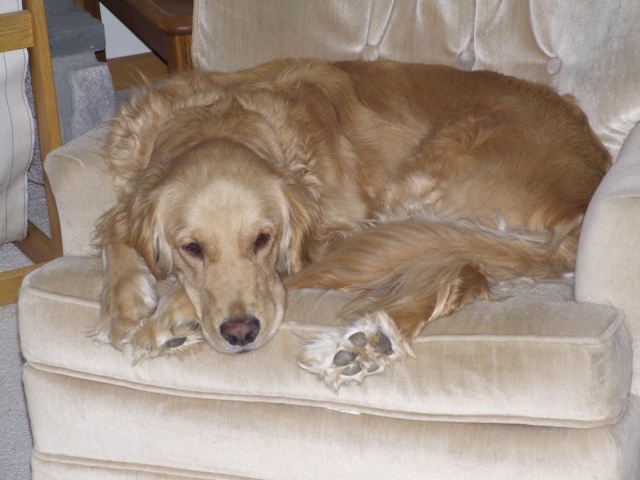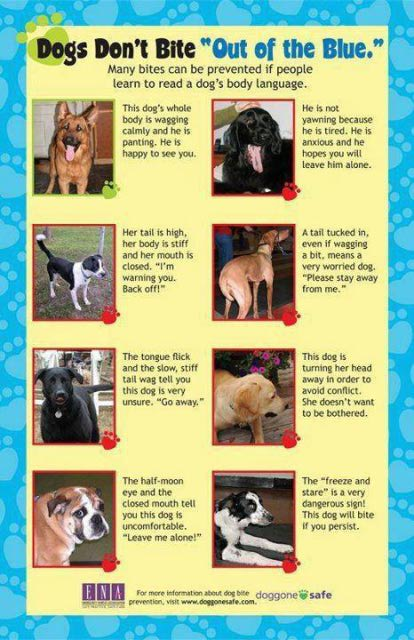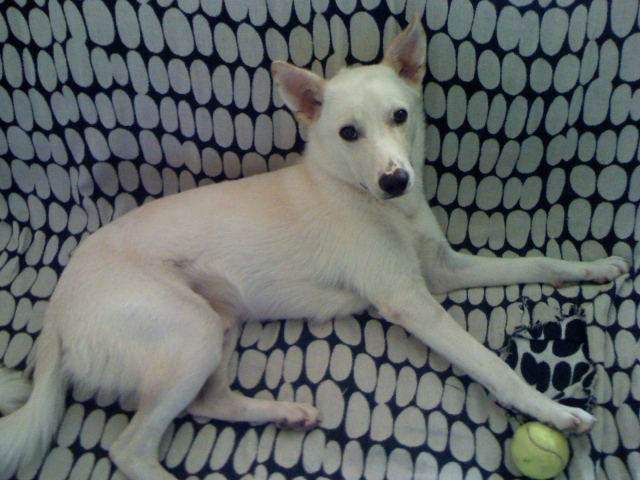QuestionHi! We have a 3 year old Aussie Shepherd mix male rescue dog, Jake. He can be a very sweet dog when he's at home, very affectionate and always wants to be near me. He is house trained, has a large fenced yard to play in, and Unfortunately he has some very bad behavior that I can't seem to correct:
1. He goes bonkers whenever I walk out the front door or go into the attached garage, presumably because he thinks I'm leaving. He will bark incessantly for at least 5-10 minutes and then gives up.
2. He is completely petrified of loud noises, vacuums, washer, dryers, anything that hums basically...he won't even walk on the linoleum floor in the bathroom, no idea why.
3. He loves to jump inside the car but as soon as the engine is started, he starts shaking, crying, whining (very very loudly), pacing, etc and so we no longer take him in the car. I've tried crating him, drugging him, giving him toys, etc but nothing works.
4. He has attacked other dogs without provocation...we had a run in at a dog park where he latched onto a Lab's neck and we could not get him off until we lifted his back legs and took away his leverage...the other dog ended up with a small amount of blood and we got lucky that the other owner was very understanding and wrote it off to dog behavior. He has never bitten a person which is great but we are thinking about having a baby and this behavior concerns me with little ones.
5. He is petrified of water...any water except what is in his bowl...he has to be tied up to be bathed and will not go into any bodies of water...this is not a huge concern but I find it weird that a dog doesn't like water.
6. We have him on a daily dose of Prozac but it doesn't seem to help. I have tried working with the vet to up the dosage, add other medications, etc but I just don't see any improvement and don't want to keep medicating him if it doesn't help.
7. We just got another dog, a one year old male Beagle, Jasper, and he doesn't seem to be bonding with him at all.
The bottom line is that Jake is not a very fun dog to have because of these behaviors. I feel like I am constantly yelling at him and the new dog is starting to exhibit some of the same behaviors (constant barking, etc) and I cannot handle two dogs that act like this. I have gotten referrals to dog therapists but I recently lost my job and cannot afford it right now. Unfortunately, I don't have any information about Jake's early life before we got him so I can't put my finger on why he acts like he does other than it being a breed behavior. Can you help me figure out what is going on and what I can do? He's my first dog and I don't want to give him up but he is driving me nuts and making me not like having him around :(.
Answer1. Go out the door. Wait until the dog stops barking (no matter how long it takes), count to ten, walk back in; repeat; repeat; repeat. Do this several times in a row every day until the dog has learned that NOT BARKING is rewarding.
2. There's nothing you can do about loud noises: the dog is hypersensitive as many dogs are. This behavior must be ABSOLUTELY IGNORED as if it weren't occurring. Trying to console him or convince him that there's nothing to fear will make it WORSE.
The linoleum floor might seem "unusual" to him or he may have slipped on flooring at a previous time and is now fearful. Putting a special treat ten inches ahead of the dog may convince him to go forward to get it. If this works, praise and end event. Repeat again a little later by placing the treat a little farther into the room. Let him VOLUNTARILY DECIDE to go forward to the treat. If he refuses, pickup the treat and leave the area, try again in a few minutes. The obvious purpose is to build new associations with the linoleum floor, SLOWLY teaching him it is rewarding to walk to the treat, which will extinguish (over time) his fear of voluntarily using this flooring. This will take TIME AND PATIENCE.
3. Many dogs are terrified of the car. It's possible he was dumped (taken for a "ride") by someone or got car sick which can create a very negative association between the engine noise and the movement that caused his nausea (in the past). Crate the dog GENTLY when it's necessary for him to go in the car. Cover the crate with a sheet: sometimes movement of things going past frighten the dog further. Some dogs NEVER travel well and there's very little one can do to change this. If you are persistent, you can attempt: put dog in car, food reward, remove dog from car, repeat several times a day. Put dog in car, start engine, ignore his behavior (do NOT move the car), wait for him to stop (it might take quite a long time), food reward, turn off engine, remove dog. Repeat this until dog no longer exhibits stress when engine starts. Next: after putting dog into car and starting engine (with large food reward), move forward on the driveway or down the street a few feet, IGNORE the dog no matter what he does, stop the car: the dog will calm (even if it takes half an hour), food reward, remove dog (leave car where it is and go back to get it without the dog). SLOWLY building new associations with the car, its sound, its movement, MAY reduce or extinguish his fear.
4. Your dog is dog aggressive: WHY and to WHAT DEGREE I do not know (I can't see anything from here). He obviously CANNOT BE TAKEN TO DOG PARKS. If another dog approaches while you are walking him on leash, REDIRECT him. Do this by immediately walking in a tight circle, first left, then right, then STOP and ask for a trained behavior (ONLY positive reinforcement training), heavily food reward, go forward. Do this EVERY TIME, do NOT be ANXIOUS (carry tic tacs), the adrenaline on your breath can be smelled by the dog and anxiety goes right down the leash. By circling you are changing his eye movements and thus his brain wave patterns: the fight/flight response is disengaged and the dog learns that he is "working" and will be rewarded. Teach this dog to give you attention:
http://www.youtube.com/watch?v=g8dC8-U1BT4&feature=more_related
Teach this dog to "sit" voluntarily on leash:
http://www.youtube.com/watch?v=Saa13XvCdlI
LEARN about positive reinforcement training and begin to use it daily:
http://www.youtube.com/watch?v=Hv38ornzzuQ
5. Non-issue. Many dogs fear water for many reasons. If dog needs to be bathed, get in the shower WITH HIM, food reward him, make it FUN.
NEVER YELL NO OR LOSE YOUR PATIENCE WITH ANY DOG.
6. Talk to the veterinarian about weaning this dog OFF the SSRI (Prozac). SSRIs INCREASE ANXIETY IN HUMANS and can also provoke AGGRESSION in humans, the dog can't TELL us what the side effects are. Do NOT just STOP: he has to be weaned off this medication. If any medication is required, I would suggest a calming agent at the lowest possible prescription level for his weight.
7. VERY BAD MOVE TO ADD ANOTHER DOG TO THIS SITUATION, ESPECIALLY SINCE YOU ARE THINKING OF HAVING A BABY. The new dog will almost always take cues from the resident dog. Fear is contagious. You have no control over the first dog and now have taken on a difficult breed (Beagle can be noisy, destructive and WILL steal food, garbage, etc.) Your present dog is IGNORING the Beagle as a social statement of hierarchy: is he there first, it's "his" environment, he's doing what is NORMAL and the Beagle understands the message. Getting another dog when you have one that has proven itself to be dog aggressive is a questionable behavior. If your first dog is not demonstrating aggression to the Beagle, then his dog to dog aggression is most likely the result of too much stimulation (outdoors) and the possibility of dog to dog communication (which I couldn't see) that provoked your dog's behavior.
It's a lifelong commitment when one acquires any animal companion. This dog has nowhere to go. Regardless of finances, your dog absolutely requires some expert intervention (NOT A DOG TRAINER). Look for a positive reinforcement training venue, examine the trainer's credentials (be certain s/he HAS REAL credentials), observe classes (NO COERCION, NO CHOKER COLLARS, NO YELLING, ONLY POSITIVE REINFORCEMENT) and enroll your dog in a basic obedience class. If he is unable to work in this environment, the TRAINER IS FAILING. If you can find a "growl class", attend it. You can see such a class in action in the following:
http://www.youtube.com/watch?v=9zQAgY-fk6A
http://www.youtube.com/watch?v=yTj9ntQj5zU&feature=related
http://www.youtube.com/watch?v=QoIEcqdtsY4&feature=related
http://www.youtube.com/watch?v=fLERx9XR8pU&feature=related
Learn what dog training should be:
http://www.youtube.com/watch?v=wTkYvn1HjrI&NR=1&feature=fvwp
A certified applied animal behaviorist might be expensive but that Prozac must be costing you a fortune and it might be doing more harm than good. You can find a certified applied animal behaviorist at one of these sites:
http://certifiedanimalbehaviorist.com/page6.html
http://www.arkanimals.com/ark/dg_expert_referrals.html
http://www.animalbehavior.org/ABSAppliedBehavior/caab-directory
This dog appears to have several fears, most of which are probably acquired from past experience or total lack of socialization and habituation as a puppy and into young adulthood. One book that can assist you to address them is Nicole Wilde's "Help for Your Fearful Dog". Remember: you must be CALM, CONSISTENT, PATIENT and REWARD the dog for the things you LIKE while ignoring the things you don't like. Adopted dogs are NOT instant "pets", they are dumped by other people and there are usually reasons (caused BY those other people).
Whether or not both your dogs will respond well to a newborn or toddler is not something I can determine. This all depends upon the CALM nature of YOUR household, YOUR training method, the work YOU have done to make both dogs feel secure and well led, and their individual socialization to children. For this purpose, you absolutely require an expert's opinion. Both dogs must be observed in proximity to children, their body language understood, and both must be firmly willing to voluntarily "work" for reward in order for anyone to be able to predict future behavior toward a child in your home.

 aggression in aging dog
Question
Niko
I have a thirteen year old, female, Samoy
aggression in aging dog
Question
Niko
I have a thirteen year old, female, Samoy
 Agressive 1 yr old mini goldendoodle
Question
our millie
My husband and I got our min
Agressive 1 yr old mini goldendoodle
Question
our millie
My husband and I got our min
 uncontrollable beagle
Question
max
My beagle is a year and a half. Ive had hi
uncontrollable beagle
Question
max
My beagle is a year and a half. Ive had hi
 Is this aggression, dominance, or play?
QuestionQUESTION: I have a question regarding doggy beh
Is this aggression, dominance, or play?
QuestionQUESTION: I have a question regarding doggy beh
 Dog walking problems
Question
Snickers
I have been trying to train my dog SN
Dog walking problems
Question
Snickers
I have been trying to train my dog SN